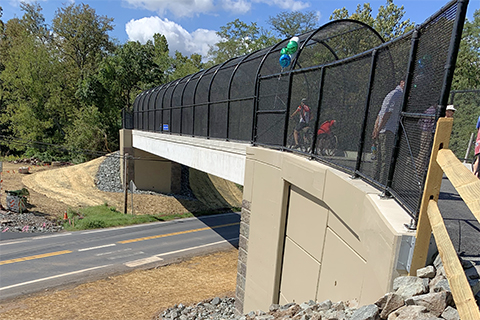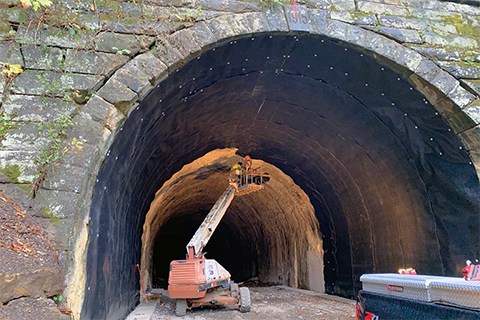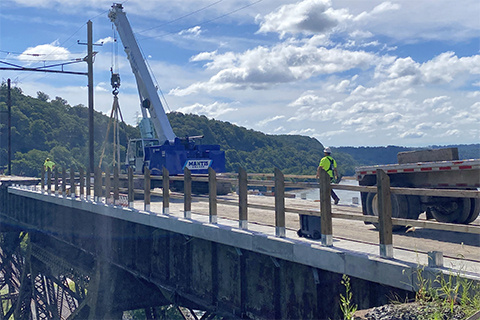As Trails Month comes to a close in Pennsylvania, we’re highlighting the work being done to ensure the commonwealth continues as a top trail state.
That work is guided by the recently released Pennsylvania Land and Water Trail Network Strategic Plan (PDF). The plan is a blueprint for state and local governments, trail providers, and other stakeholders to guide Pennsylvania’s trail stewardship and expansion for the next five years.
Pennsylvania Trail Vision and Goal

The recently completed Schuylkill River Trail bridge over SR 724 in Berks County eliminates a dangerous road crossing.
Pennsylvania’s trail vision is to develop a statewide land and water trail network to facilitate recreation, transportation, and healthy lifestyles for all.
The Trail Plan provides seven recommendations with 40 action steps and identifies implementing strategies and partners.
It is a companion document to the Statewide Outdoor Recreation Plan, which sets Pennsylvania’s goal of providing a trail within 10 minutes of every Pennsylvanian. A big focus is on closing trail gaps to meet that goal.
Since 2008, DCNR had been asking trail managers, builders, and advocates to provide information about gaps, voids, missing links, or connections between existing trails. The intent is to focus resources on the gaps in long distance trails to speed up the completion.
The results were an eclectic mix of 248 “trail gaps” that ranged from well-defined projects (such as a bridge or tunnel) to indefinite, long-distance ideas for connections between trail systems.
Although lots of gaps had been identified, it appeared that few were actually being closed.
Prioritizing Trail Gaps

Work continues to open the Brady Tunnel along the Armstrong Trail -- a Top 10 Trail Gap in Clarion County.
To bring more attention to trail gaps, in 2014, DCNR established a list of the Top 10 Trail Gaps. Generally, these are the most challenging and critical projects that would connect existing trails together.
This effort is meeting with success. More than $9 million was raised that closed three Top 10 Trail Gaps and three are on track to close in 2022. It provides local trail builders and state agencies a place to focus and coordinate efforts and resources.
Success with the Top 10 Trail Gaps taught us that more clearly defined gaps of a manageable size is what was needed if we wanted to see progress on closing trail gaps.
So, the 2018 workgroup established more stringent criteria for Priority Trail Gaps to bring some of the success experienced with the Top 10 Trail Gaps to a larger number of gaps.
The new criteria whittled down the number of Priority Trail Gaps from 248 to 112 well-defined projects that connect existing sections of trail. With the establishment of a solid set of criteria for Priority Trail Gaps, it’s time to take the next step.
New Tool to Track and Implement Trail Projects

Progress is underway on the Safe Harbor Bridge, a Top 10 Trail Gap along the Enola Low Grade Trail in Lancaster County.
One of the seven major recommendations of the Trail Plan is to “Close priority trail gaps in Pennsylvania’s statewide land and water trail network with the overall goal of having a trail within 10 minutes of every Pennsylvanian.”
The establishment of this recommendation was supported by the survey data collected during the development of the plan, which revealed that closing trail gaps and leveraging funding between agencies on common priority projects were of highest importance.
Trails are critical public infrastructure -- as was made clear during the pandemic -- and now is the time to treat them as such by evolving our strategy and establishing a statewide system of identifying and managing their yet-to-be-built miles of trail.
To accomplish this, DCNR is partnering with the Pennsylvania Environmental Council to provide trail managers with an online GIS tool to submit their trail gaps. The tool is called the Trail Implementation and Management tool.
In addition to being the method for submitting trail gaps, the tool will allow trail managers to manage their own trails and trail projects while helping to inform funding strategies and decisions at the state-level by providing a data set from across the state.
With more than 12,000 miles of trails, Pennsylvania offers lots of opportunities for taking a walk, paddle, or ride. New action steps outlined in the strategic plan will make those opportunities even better.